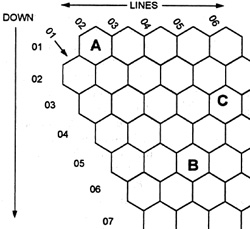
My son, Paul, is the most active solo wargamer in the family. Recently he came up with a new way to play postal games. For some years, Paul has been playing "World in Flames" as a solo game. "World in Flames" is a big game designed by Australian Design Group. It covers World War n using two boards: European Theatre of Operations and Asia and the Pacific. There is an expansion set for Africa. The game includes 1200 counters. It can be coupled with another game called "Days of Decision", which covers political events before World War II.
Paul played a variety of scenarios. What if Spain entered the war on the Axis side? What if Turkey entered on the Axis side? What if Russia entered later? Playing time stretched over several days, so he kept the board stowed under his bed so the kids wouldn't rearrange the counters.
Paul's has access to the Intemet. Paul has tried to explain this to me. My understanding of computers is limited. I think "hard drive" is a trip of over a hundred miles in a snow storm and CD ROM is one of the new country-westem singers. As Paul explains the Intemet to me, it means he can get on his computer and tap into the Intemet and find all kinds of information . The Intemet is global. Once on it, an operator can contact people from all over the world. In spare moments, Paul explored the wargaming information. There seems to be a lot of wargaming material. Even I know there was an article in Midwest Wargamers Association Newsletter (MWAN) listing several E-mail addresses for wargaming articles.
Paul found some of these and contacted another fan of"World in Flames." Paul had played a few postal games, so he was familiar with postal gaming techniques. They had to modify the game a bit, but soon Paul and his Email contact were playing an E-mail game of "World in Flames." They use alternate moves and had to devise a system of numbered hexes to tell the location of units and their moves.
"World in Flames" does not have numbers on its hexes, so they developed a system to designate hexes by a number pair. They assign each line of hexes slanting Southeast a number by putting numbers across the top of the map and extending beyond. Then they add a second number for the place of the hex down the line. Hex 02 05, for example, is the second hex down in the fifth line of hexes. (see illustration at end of article)
They have codes for units. Most land units have two numbers, combat number and movement allowance. An ordinary infantry unit would be 5-3. Some elite units are marked with W, W94, for example. They add designations like PARA for paratroopers, MAR for marines and CAV for cavalry. They also add nabonalities using the shortest nonredundant designation: H for Hungarians, R for Romanian, for example. Thus, H94 PARA is a Hungarian parachute unit. The critical thing is to clearly identify each unit. Each move starts with a letter to identify which map it is on: E=Europe; A=Asia. Then they specify the starting hex numbers, the unit, number of hexes moved and direction, end hex number, a code for attack etc. and the target hex. A typical move order looks like this: E 02 05 H9-4 PARA SE SE 04 05 A105 05. It reads: E=Europe map, starting at hex 02 05 the Hungarian parachute unit moves two hexes Southeast to hex 04 05. If any hex is a city or landmark it is named. "Stalingrad" is easier to locate than hex 09 05. At the end of each list of orders they also list attacks. This redundancy helps clarify things. Even with all this, there is still some confusion about where units are. But that can be attributed to "fog of war."
Most of the above is more or less typical of postal play. There is me problem of doing die rolls in any postal. In this game they simply trust each other. Paul reports that E-mail is very fast. His opponent usually gets Paul's move and has made his reply within a day. In the old days, postal moves took two weeks to a month.
It looks to me like the lntemet has real potential as a vehicle for gaming with a distant opponent. It could end long delays between moves. Some games would adapt easily. The World War I dogfight game "Ace of Aces" could be played by two players chatting with computers. Other games might require some modifications for E-mail "postal" play as "World in Flames" did. The techniques are much like regular postal gaming. Perhaps Lone Warrior could carry a list of players, games and E-mail addresses as part of our postal game listing. Just don't look for me on the list. I'm still trying to figure out how to wire in a modem. There is one other small problem I have with our computer. How do you turn it on? [I am more than willing to list members email addresses in Lone Warrior, you will have noted Bob Walker's in 114, just send them to him. Bob is our email contact. Kenn]
| Hex | Down | Line |
|---|---|---|
| A: | 01 | 02 |
| B: | 05 | 03 |
| C: | 03 | 05 |

Back to Table of Contents -- Lone Warrior 115
© Copyright 1996 by Solo Wargamers Association.
This article appears in MagWeb (Magazine Web) on the Internet World Wide Web.
Other military history articles and gaming articles are available at http://www.magweb.com
